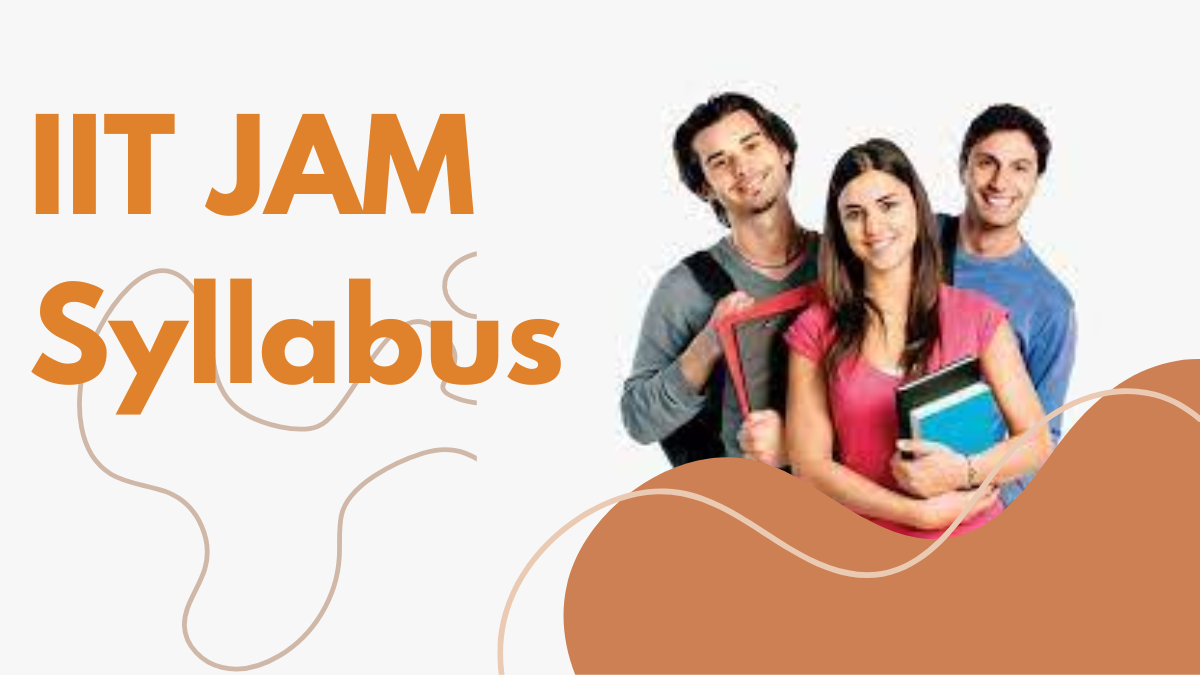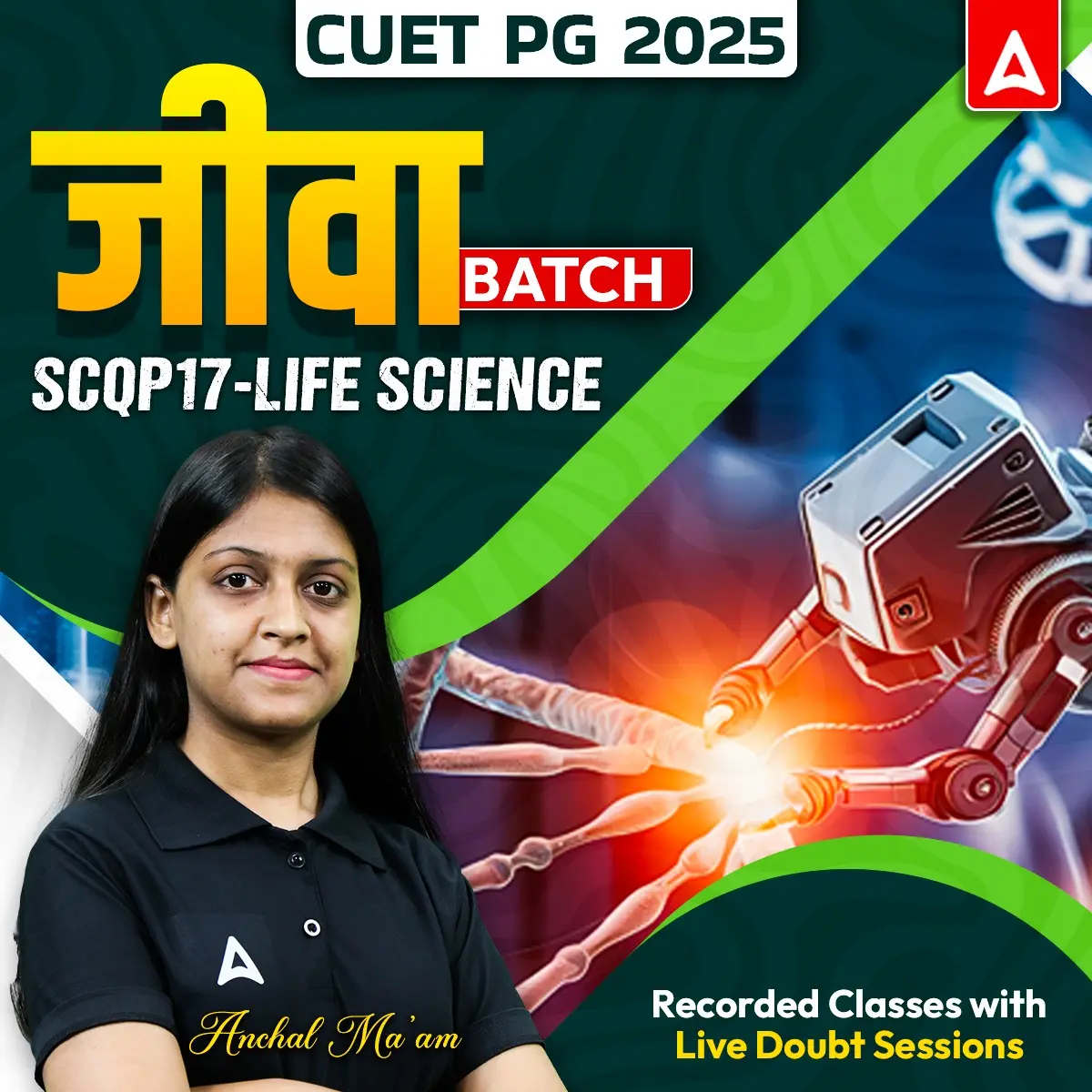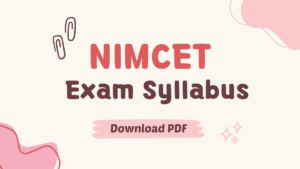IIT JAM Syllabus is very crucial for the students who plan to take the JAM entrance exam in the coming days. JAM 2025 aspirants need to to familiarize themselves with the IIT JAM 2025 syllabus. The authority has issued the IIT JAM syllabus 2025 for all subjects. The IIT JAM 2025 exam includes seven subjects: Economics, Mathematical Statistics, Biotechnology, Mathematics, Chemistry, Geology, and Physics. In this article, we provide you with a detailed syllabus of Chemistry, Physics, Statistics, Biotechnology, Mathematics, Geology and Biological Sciences.
IIT JAM 2025 syllabus
Completing the IIT JAM syllabus 2025 is the initial step in ensuring a good rank in the exam. IIT Delhi is going to conduct IIT JAM 2025 exam on February 02, 2025 in online mode. The IIT JAM 2025 Exam (Joint Admission Test for Master’s) is a gateway to get admission into India’s prestigious institutions like the Indian Institute of Sciences and IITs.
The IIT JAM Question Paper is completely based on the JAM syllabus. Candidates must view each subject, topic, and subtopics of the syllabus. As a result, they can prepare each subject’s Topics and subtopics effectively for the JAM exam 2025. Let’s Explore the IIT JAM syllabus for all 7 subjects with their topics, and subtopics.
- Biotechnology (BT),
- Chemistry (CY),
- Geology (GG),
- Mathematical Statistics (MS),
- Biological Sciences (BL),
- Mathematics (MA),
- Physics (PH).
JAM 2025 Syllabus: Overview
The Joint Admission Test for Master’s is a national-level entrance test by IITs and Indian Institutes of Science in a rotating shift. The IIT Delhi has already released the JAM 2025 admit card on January 06, 2025.
By passing the exam, candidates will be admitted to full-time M.Sc. (two years), M.Sc.-Ph.D. dual degree, joint M.Sc.-Ph.D., and other post-bachelors degree programs at various IITs, as well as integrated Ph.D. programs at the IISc. Check out the JAM exam pattern 2025 in the below table:
| IIT JAM Syllabus 2025 & Exam Pattern | |
| Name of Examination | Joint Admission Test for Master’s (JAM 2025) |
| Exam conducting body | IITs and Indian Institutes of Science (Rotational) |
| Number of Questions | 60 questions |
| Duration of Exam | 3 hours |
| Language | English |
| Exam mode | CBT mode |
| Subjects included in JAM syllabus | 7 subjects. Economics, Mathematical Statistics, Biotechnology, Mathematics, Chemistry, Geology, and Physics |
| Total Marks | 100 Marks |
| Sections | Section 1: 30 Multiple-choice questions (50 Marks) |
| Section 2: 10 Multiple-choice questions (20 Marks) | |
| Section 3: 20 Numerical answer type questions (30 Marks) | |
| Negative Marking | Only for section I. |
IIT JAM 2025 Syllabus PDF
Candidates who plan to take the JAM Exam can download the IIT JAM 2025 Syllabus PDF from the official website at https://jam.iitm.ac.in/.Candidatse should download the JAM 2025 Syllabus Pdf of their subjects and start their preparation accordingly. To make things easier here we have provided the direct link to download the syllabus Pdf of all the seven subjects.
| IIT JAM Syllabus 2025 PDF Download | |
| IIT JAM Physics Syllabus 2025 Pdf | Click here |
| IIT JAM Chemistry Syllabus 2025 Pdf | Click here |
| IIT JAM Biology Syllabus 2025 Pdf | Click here |
| IIT JAM Maths Syllabus 2025 Pdf | Click here |
| IIT JAM Biotechnology Syllabus 2025 Pdf | Click here |
| IIT JAM Mathematical statistics Syllabus 2025 Pdf | Click here |
| IIT JAM Geology Syllabus 2025 Pdf | Click here |
JAM 2025 Detailed Syllabus
Candidates planning to take the JAM Exam ought to introduce themselves with the IIT JAM syllabus 2025 well in advance. The syllabus for IIT JAM 2025 test has been given for all seven subjects, including Economics, Mathematical Statistics, Biotechnology, Mathematics, Chemistry, Geology, and Physics. If you have applied for any of these disciplines, you should review the most recent IIT JAM syllabus given below.
IIT JAM Physics Syllabus 2025
Check out the section-wise IIT JAM Physics Syllabus 2025 given below:
| IIT JAM Physics Syllabus 2025 |
| Unit- 1: Mathematical Methods |
| Calculus of single and multiple variables, Multiple integrals, Stokes’ theorem, partial derivatives, Jacobian, Matrices and determinants, imperfect and perfect differentials.
Taylor expansion, Divergence theorem, Fourier series. First-order equations and linear second-order differential equations with constant coefficients. Vector algebra, Vector Calculus, Green’s theorem. Algebra of complex numbers. |
| Unit- 2: Mechanics and General Properties of Matter |
| Velocity and acceleration in Cartesian, centrifugal, and Coriolis forces, Newton’s laws of motion and applications, Conservative and non-conservative forces.
Polar and cylindrical coordinate systems, uniformly rotating frame, Kepler’s laws, Gravitational Law and field, Motion under a central force. System of particles. conservation of linear and angular momentum, Center of mass, conservation of energy, equation of motion of the CM, variable mass systems. Rigid body motion, moments of Inertia and products of Inertia. rotation and translation, parallel and perpendicular axes theorem. Principal moments and axes, fixed axis rotations. Euler’s equation. Kinematics of moving fluids, Bernoulli’s theorem, equation of continuity. Elastic and inelastic collisions. |
| Unit- 3: Oscillations, Waves and Optics |
| Lissajous figures. Damped and forced oscillators, resonance. Differential equation for simple harmonic oscillator and its general solution.
Traveling and standing waves in one-dimension, Wave equation. Superposition of two or more simple harmonic oscillators. Energy density and energy transmission in waves. Group velocity and phase velocity. Fermat’s Principle. Interference of light, optical path retardation. General theory of image formation. Thin lens and lens combinations, Thick lens. Fraunhofer diffraction. Rayleigh criterion and resolving power. Doppler Effect. Diffraction gratings. Polarization: linear, circular and elliptic polarization. Double refraction and optical rotation. Sound waves in media. |
| Unit- 4: Electricity and Magnetism |
| Conductors, capacitors, dielectrics, dielectric polarization, volume and surface charges, electrostatic energy. Coulomb’s law, Gauss’s law. Electric field and potential.
Electrostatic boundary conditions, Solution of Laplace’s equation for simple cases. Biot-Savart law, Ampere’s law, Faraday’s law of electromagnetic induction, Self and mutual inductance. Alternating currents. Simple DC and AC circuits with R, L and C components. Maxwell’s equations and plane electromagnetic waves, Displacement current, Poynting’s theorem, transmission and reflection coefficients (normal incidence only) reflection and refraction at a dielectric interface. Lorentz Force and motion of charged particles in electric and magnetic fields. |
| Unit- 5: Kinetic theory, Thermodynamics |
| Elements of Kinetic theory of gases. Velocity distribution and Equipartition of energy. Specific heat of Mono-, di- and tri-atomic gases. Ideal gas, van-der-Waals gas and equation of state. Mean free path.
Laws of thermodynamics. Zeroth law and concept of thermal equilibrium. First law and its consequences. Isothermal and adiabatic processes. Reversible, irreversible and quasi-static processes. Second law and entropy. Carnot cycle. Maxwell’s thermodynamic relations and simple applications. Thermodynamic potentials and their applications. Phase transitions and Clausius-Clapeyron equation. Ideas of ensembles, Maxwell-Boltzmann, Fermi-Dirac and Bose-Einstein distributions. |
| Unit – 6: Modern Physics |
| Inertial frames and Galilean invariance. Postulates of special relativity. Lorentz transformations. Length contraction, time dilation. Relativistic velocity addition theorem, mass-energy equivalence.
Blackbody radiation, photoelectric effect, Compton effect, Bohr’s atomic model, X-rays. Wave-particle duality, Uncertainty principle, the superposition principle, calculation of expectation values, Schrödinger equation and its solution for one, two and three-dimensional boxes. Solution of Schrödinger equation for the one-dimensional harmonic oscillator. Reflection and transmission at a step potential, Pauli exclusion principle. Structure of atomic nucleus, mass and binding energy. Radioactivity and its applications. Laws of radioactive decay. |
| Unit – 7: Solid State Physics, Devices and Electronics |
| Crystal structure, Bravais lattices and basis. Miller indices. X-ray diffraction and Bragg’s law; Intrinsic and extrinsic semiconductors, Variation of resistivity with temperature.
Fermi level. p-n junction diode, I-V characteristics, Zener diode and its applications, BJT: characteristics in CB, CE, CC modes. Single-stage Amplifier, two-stage R-C coupled amplifiers. Simple Oscillators: Barkhausen condition, sinusoidal oscillators. OPAMP and applications: Inverting and non-inverting amplifier. Boolean algebra: Binary number systems; conversion from one system to another system; binary addition and subtraction. Logic Gates AND, OR, NOT, NAND, NOR exclusive OR; Truth tables; Combinations of gates; de Morgan’s theorem. |
IIT JAM Chemistry Syllabus 2025
The IIT JAM Chemistry Syllabus 2025 is divided into three sections, Physical chemistry, organic chemistry, and inorganic chemistry. Check out the section-wise IIT JAM Chemistry Syllabus 2025 given below:
IIT JAM Chemistry Syllabus 2025 for Physical Chemistry
Check out the topics included in the Physical Chemistry syllabus IIT JAM 2025 exam below.
| Units | Topics |
| Basic Mathematical Concepts |
Functions, Maxima and Minima, Integrals, Ordinary Differential Equations, Vectors and Matrices, Determinants, Elementary Statistics and Probability Theory
|
| Atomic and Molecular Structure |
Fundamental Particles, Bohr’s Theory of Hydrogen-like Atom, Wave-Particle Duality, Uncertainty Principle, Schrödinger’s Wave Equation, Quantum Numbers, Shapes of Orbitals, Hund’s Rule and Pauli’s Exclusion Principle, Electronic Configuration of Simple Homonuclear Diatomic Molecules
|
| Theory of Gases |
Equation of State for Ideal and Non-Ideal (Van Der Waals) Gases, Kinetic Theory of Gases, Maxwell-Boltzmann Distribution Law, Equipartition of Energy.
|
| Solid state |
Crystals and Crystal Systems, X-rays, NaCl and KCl Structures, Close Packing, Atomic and Ionic Radii, Radius Ratio Rules, Lattice Energy, Born-Haber Cycle, Isomorphism, Heat Capacity of Solids.
|
| Chemical Thermodynamics |
Reversible and Irreversible Processes, First Law and Its Application to Ideal and Non-ideal Gases, Thermochemistry, Second Law, Entropy and Free Energy, Criteria for Spontaneity.
|
| Chemical and Phase Equilibria |
Law of Mass Action, Kp, Kc, Kx and Kn, Effect of Temperature on K, Ionic Equilibria in Solutions, PH and Buffer Solutions, Hydrolysis, Solubility Product, Phase Equilibria–Phase Rule and its Application to One-Component and Two-Component Systems, Colligative Properties
|
| Electrochemistry |
Conductance and its Applications, Transport Number, Galvanic cells, EMF and Free Energy, Concentration Cells with and without Transport, Polarography, Concentration cells with and without Transport, Debye-Huckel-Onsager Theory of Strong Electrolytes, Chemical Kinetics, Reactions of Various Order, Arrhenius Equation, Collision Theory, Transition State Theory, Chain Reactions – Normal and Branched, Enzyme Kinetics, Photochemical Processes, Catalysis.
|
| Adsorption |
Gibbs Adsorption Equation, Adsorption Isotherm, Types of Adsorption, Surface Area of Adsorbents, Surface Films on Liquids.
|
| Spectroscopy |
Beer-Lambert Law, Fundamental Concepts of Rotational, Vibrational, Electronic and Magnetic Resonance Spectroscopy.
|
IIT JAM Chemistry Syllabus 2024 for Organic Chemistry
Check out the Topics included in the IIT JAM 2025 syllabus for Organic Chemistry.
| Units | Topics |
| Basic Concepts in Organic Chemistry and Stereochemistry |
Electronic Effects (Resonance, Inductive, Hyperconjugation) and Steric Effects and its Applications (Acid/Base Property), Optical Isomerism in Compounds with and without any Stereocenters (Allenes, Biphenyls), Conformation of Acyclic Systems (Substituted Ethane/n-Propane/n-Butane) and Cyclic Systems (Mono- and Di-Substituted Cyclohexanes).
|
| Organic Reaction Mechanism and Synthetic Applications |
Dozens Reaction, Wittig Reaction and McMurry Reaction, Pinacol-Pinacolone, Favorskii, Benzilic Acid Rearrangement, Dienone-Phenol Rearrangement, Baeyer-Villiger Reaction, Oxidation and Reduction Reactions in Organic Chemistry, Organometallic Reagents in Organic Synthesis (Grignard, Organolithium and Organocopper), Diels-Alder, Electrocyclic and Sigmatropic Reactions, Functional Group Interconversions and Structural Problems using Chemical Reactions, Chemistry of Reactive Intermediates (Carbocations, Carbanions, Free Radicals, Carbenes, Nitrenes, Benzynes etc…), Hofmann-Curtius-Lossen Rearrangement, Wolff Rearrangement, Simmons-Smith Reaction, Reimer-Tiemann Reaction, Michael Reaction.
|
| Qualitative Organic Analysis |
Identification of Functional Groups by Chemical Tests, Elementary UV, IR and 1H NMR Spectroscopic Techniques as Tools for Structural Elucidation
|
| Natural Products Chemistry |
Chemistry of Alkaloids, steroids, Terpenes, Carbohydrates, Amino Acids, Peptides and Nucleic Acids.
|
| Aromatic and Heterocyclic Chemistry |
Monocyclic, Bicyclic and Tricyclic Aromatic Hydrocarbons, and Monocyclic Compounds with One Hetero Atom, Synthesis, Reactivity, and Properties.
|
IIT JAM Syllabus 2025 for Inorganic Chemistry
Check out the Topics included in the IIT JAM 2025 syllabus for Inorganic Chemistry
| units | Topics |
| Main Group Elements (s and p blocks) |
General concepts on Group Relationships and Gradation in Properties, Structure of Electron Deficient Compounds involving Main Group Elements
|
| Periodic Table |
Periodic Classification of Elements and Periodicity in Properties, General Methods of Isolation and Purification of Elements, Chemical Bonding and Shapes of Compounds, Types of Bonding, VSEPR Theory and Shapes of Molecules, Hybridization, Dipole Moment, Ionic Solids, Structure of NaCl, CsCl, Diamond and Graphite, Lattice Energy
|
| Bioinorganic Chemistry |
Essentials and Trace Elements of Life, Basic Reactions in Biological Systems and the Role of Metal Ions, especially Fe2+, Fe3+, Cu2+ and Zn2+, Structure and Function of Hemoglobin and Myoglobin and Carbonic Anhydrase.
|
| Transition Metals (d block) |
Characteristics of 3d Elements, Oxide, Hydroxide and Salts of First Row Metals, Coordination Complexes, Structure, Isomerism, Reaction Mechanism and Electronic Spectra, VB, MO and Crystal Field Theoretical Approaches for Structure, Color and Magnetic Properties of Metal Complexes, Organometallic Compounds having Ligands with Back Bonding Capabilities such as Metal Carbonyls, Carbenes, Nitrosyls and Metallocenes, Homogeneous Catalysis.
|
| Instrumental Methods of Analysis |
Essentials and Trace Elements of Life, Basic Reactions in Biological Systems and the Role of Metal Ions, especially Fe2+, Fe3+, Cu2+ and Zn2+, Structure and Function of Hemoglobin and Myoglobin and Carbonic Anhydrase.
|
| Analytical Chemistry |
Principles of Qualitative and Quantitative Analysis, Acid-Base, Oxidation-Reduction and Complexometric Titrations using EDTA, Precipitation Reactions, Use of Indicators, Use of Organic Reagents in Inorganic Analysis, Radioactivity, Nuclear Reactions, Applications of Isotopes.
|
IIT JAM Biology Syllabus 2025
Check out the section-wise IIT JAM Biology Syllabus 2025 given below:
| IIT JAM Biology Syllabus 2025 |
| Unit – 1: Genetics |
| Mendel’s laws; Inheritance patterns of polygenic traits; Mendelian inheritance patterns of human disorders; Pedigree analysis; Chromosomal basis of inheritance; Genetic recombination; Mapping genes on chromosomes based on linkage analysis; Plant breeding. |
| Unit – 2: Biochemistry |
| Structure and function of biological macromolecules; Allostery; Enzymes – basic mechanisms of enzyme catalysis, Michaelis-Menten kinetics, enzyme inhibition, vitamins as coenzymes, and regulation; Bioenergetics – free-energy change, high-energy compounds, biological oxidation-reduction reactions and reduction potential;
Metabolism – glycolysis, TCA cycle, oxidative phosphorylation, photosynthesis, nitrogen fixation, urea cycle, and regulation of glycolysis and TCA cycle. |
| Unit – 3: Biotechnology |
| Plant tissue culture; Cloning of animals through somatic cell nuclear transfer; Applications of recombinant DNA technology in medicine, agriculture and forensic science. |
| Unit – 4: Molecular Biology |
| Landmark experiments that established DNA is the genetic material; DNA replication; Proofreading and repair of DNA; DNA recombination; Transcription; RNA processing; Translation; Regulation of gene expression including operons bacteria and differential gene expression in multicellular eukaryotes. |
| Unit – 5: Cell Biology |
| Structure of prokaryotic and eukaryotic cells; Membrane structure and function; Organelles and internal organization of the eukaryotic cell Protein trafficking in a eukaryotic cell; Cell communication – signalling pathways: endocrine and paracrine signalling; Extracellular matrix and apoptosis; Cell cycle – stages of mitosis and meiosis, and control of cell division cycle. |
| Unit – 6: Microbiology |
| Isolation; Cultivation; Structural features of viruses, bacteria, fungi and protozoa; Pathogenic microorganisms; Nutrition-based classification of microbes; Microbial metabolism; Growth kinetics; Submerged fermentation techniques; Microbial genetics. |
| Unit – 7: Evolution |
| Darwinian view – natural selection, fossil record and descent with modification; Population genetics – sources of genetic variation, gene pools and allele frequencies, Hardy-Weinberg equation, genetic drift, gene flow and adaptive evolution; Different types of speciation; Phylogenetic classification; Origin of life – abiotic synthesis of biological macromolecules, protocell, dating fossils and origin of multicellularity. |
| Unit – 8: Plant Biology |
| Types of tissues and organs; Primary and secondary growth; Morphogenesis; Transport in vascular plants; Plant nutrition; Development of flowering plants – gametophytic and sporophytic generations, different developmental phases, genetic control of flowering, gametogenesis, incompatibility, embryogenesis, dormancy, germination and environmental influence; Plant hormones; Photobiology; Plant response to biotic and abiotic stresses |
| Unit – 8: Animal Biology |
| Digestive, circulatory, respiratory, excretory, nervous, reproductive and endocrine systems; Basics of immunology – Innate and adaptive immunity, Immune cells and Immunoglobulins; Animal development – Fertilization, embryonic pattern formation, cleavage, gastrulation, cellular differentiation and morphogenesis. |
| Unit – 9: Ecology |
| Climate patterns; Terrestrial and aquatic biomes; Environmental constraints on species distribution; Factors affecting population density; Interactions among communities; Ecosystems; Ecological remediation. |
| Unit – 10: Methods in Biology |
| Cell Biology: Microscopy (light microscopy and electron microscopy); Staining proteins with antibodies; Visualizations using the GFP reporter.
Biochemical techniques: UV spectrophotometry; Biomolecular chromatography; cell fractionation by centrifugation; Electrophoresis; and Western blotting. Molecular biology techniques: DNA cloning – plasmid vectors, and restriction enzymes; Polymerase Chain Reaction; Expression of cloned eukaryotic genes in bacteria; Hybridization techniques; DNA sequencing |
IIT JAM Biotechnology Syllabus 2025
Biology, Chemistry, Mathematics, and Physics are the four components of the IIT jam biotechnology syllabus 2025. For Biology and Chemistry, the level of questions will be 10+2+3. However, the standard of questions in Mathematics and Physics is 10+2. Check out the jam 2025 biotechnology syllabus component by section below:
|
IIT JAM 2025 Biotechnology Syllabus |
|
| Topic | JAM 2025 Biotechnology Syllabus Subtopics |
| Biology |
|
| General Biology |
Taxonomy, Heredity, Genetic variation, Conservation, Principles of Ecology, Evolution, Techniques in modern biology.
|
| Biochemistry and Physiology |
Carbohydrates, Proteins, Lipids, Nucleic acids, Enzymes, Vitamins, Hormones, Metabolism (Glycolysis, TCA cycle, Oxidative Phosphorylation, Photosynthesis), Nitrogen Fixation, Fertilization and Osmoregulation, Vertebrates-Nervous system, Endocrine system, Vascular system, Immune system, Digestive system and Reproductive System.
|
| Basic Biotechnology |
Tissue culture, Application of enzymes, Antigen-antibody interaction, Antibody production, Diagnostic aids.
|
| Molecular Biology | DNA, RNA, Replication, Transcription, Translation, Proteins, Lipids and Membranes, Operon model, and Gene transfer. |
| Cell Biology | Cell cycle, Cytoskeletal elements, Mitochondria, Endoplasmic reticulum, Chloroplast, Golgi apparatus, Signalling. |
| Microbiology | Isolation, Cultivation, Structural features of virus, Bacteria, Fungi, Protozoa, Pathogenic microorganisms. |
|
Chemistry
|
|
| Atomic Structure |
Bohr’s theory and Schrodinger wave equation, Periodicity in properties, Chemical bonding, Properties of s, p, d and f block elements, Complex formation, Coordination compounds, Chemical equilibrium, Chemical thermodynamics (first and second law); Chemical kinetics (zero, first, second and third-order reactions), Photochemistry, Electrochemistry, Acid-base concepts, Stereochemistry of carbon compounds, Inductive, electrometric, conjugative effects and resonance.
|
| Chemistry of Functional Groups | Hydrocarbons, alkyl halides, alcohols, aldehydes, ketones, carboxylic acids, amines and their derivatives, Aromatic hydrocarbons, halides, nitro and amino compounds, phenols, diazonium salts, carboxylic and sulphonic acids, Mechanism of organic reactions. |
| Synthetic polymers | Biomolecules, amino acids, proteins, nucleic acids, lipids and carbohydrates (polysaccharides), Instrumental techniques – chromatography (TLC, HPLC), electrophoresis, UV-Vis, IR and NMR spectroscopy, mass spectrometry |
| Mathematics | |
| Sets, Relations and Functions, Mathematical Induction, Logarithms, Complex numbers, Linear and Quadratic Equations, Sequences and Series, Trigonometry, Cartesian System of Rectangular Coordinates, Straight lines and Family, Circles, Conic Sections, Permutations and Combinations, Binomial Theorem, Exponential and Logarithmic Series, Mathematical Logic, Statistics, Three Dimensional, Geometry, Vectors, Matrices and Determinants, Boolean Algebra, Probability, Functions, limits and Continuity, Differentiation, Application of Derivatives, Definite and Indefinite Integrals, Differential Equations. | |
| Physics | |
| Physical World and Measurement, Elementary Statics and Dynamics, Kinematics, Laws of Motion, Work, Energy and Power, Electrostatics, Current electricity, Magnetic Effects of Current and Magne-tism, Electromagnetic Induction and Alternating Current, Electromagnetic waves, Optics, Dual Na-ture of Matter and Radiations, Atomic Nucleus, Solids and Semiconductor Devices, Principles of Communication, Motion of System of Particles and Rigid Body, Gravitation, Mechanics of Solids and Fluids, Heat and Thermodynamics, Oscillations, Waves | |
IIT JAM Biochemistry Syllabus PDF
Candidates from a chemistry background who are going to take the IIT JAM 2025 Exam can download the IIT JAM Bio Chemistry Syllabus 2025 in PDF from the Link given below.
PDF Link – IIT JAM syllabus Biochemistry PDF Download
IIT JAM Maths Syllabus 2025
The IIT JAM Syllabus 2025 for Mathematics contains 10+2+3 level topics such as Sequence & Series, Function, Vector, Differential Equations, and so on. Check out the section-wise IIT JAM Mathematics Syllabus 2025 given below:
| IIT JAM Mathematics Syllabus | |
| Chapters | Topics |
| Sequences and Series of Real Numbers | Sequence of real numbers Convergence of sequence Bounded and monotone sequences Convergence criteria for sequences of real numbers Cauchy sequences Subsequences Bolzano-Weierstrass theorem |
| Series of real numbers | Absolute convergence Tests of convergence for series of positive terms Comparison test Ratio test Root test Leibniz test for convergence of alternating series |
| Functions of Two or Three Real Variables | Limit Continuity Partial derivatives Differentiability Maxima and minima |
| Integral Calculus | Integration as the inverse process of differentiation Definite integrals and their properties Fundamental theorem of calculus Double and triple integrals Change of order of integration Calculating surface areas and volumes using double integrals Calculating volumes using triple integrals |
| Differential Equations | Ordinary differential equations of the first order of the form y’=f(x,y) Bernoulli’s equation Exact differential equations Integrating factor Orthogonal trajectories Homogeneous differential equations Variable separable equations Linear differential equations of second order with constant coefficients Method of variation of parameters Cauchy-Euler equation |
| Vector Calculus | Scalar and vector fields Gradient Divergence Curl Line integrals Surface integrals Green’s theorem Stokes’ theore Gauss’ theorem |
| Group Theory | Groups Subgroups Abelian groups Non-Abelian groups Cyclic groups Permutation groups Normal subgroups Lagrange’s Theorem for finite group Group homomorphisms Basic concepts of quotient groups |
| Linear Algebra | Finite dimensional vector spaces Linear independence of vectors Basis Dimension Linear transformations Matrix representation Range space Null space Rank-nullity theorem Rank and inverse of a matrix Determinant Solutions of systems of linear equations Consistency conditions Eigenvalues and eigenvectors for matrices Cayley-Hamilton theorem |
| Real Analysis | Interior points Limit points Open sets Closed sets Bounded sets Connected sets Compact sets Completeness of R Power series (of real variable) Taylor’s series Radius and interval of convergence Term-wise differentiation and integration of power series |
IIT JAM Geology Syllabus 2025
Check out the Units which are included in the IIT JAM Geology Syllabus 2025 below:
|
IIT JAM Syllabus 2025 Geology |
| Unit – 1: The Planet Earth |
| Origin of the Solar System and the Earth; Geosphere and the composition of the Earth; Shape and size of the Earth; Earth-Moon system; Dating rocks and age of the Earth; Volcanism and volcanic landforms; Interior of the Earth; Earthquakes; Earth’s magnetism and gravity, Isostasy; Basic elements of Plate Tectonics; Orogenic cycles. |
| Unit – 2: Geomorphology |
| Weathering and erosion; Soil formation; Transportation and deposition by wind, ice, river, sea and resulting landforms. |
| Unit – 3: Structural Geology |
| Orientation of planes and lines in space – concept of dip, strike, rake and plunge. Contour lines; Rule of ‘V’s and outcrop patterns; Interpretation of geological maps and cross-section construction;
Classification and origin of folds, faults, joints, unconformities, foliations and lineations; Stereographic and equal-area projections of planes and lines; Numerical problems related to outcrop and bore-hole data. |
| Unit – 4: Palaeontology |
| Major steps in the evolution of life forms; Fossils, their mode of preservation and utility in age determination and paleoenvironmental interpretations; Morphology, major evolutionary trends and ages of important groups of animals – Brachiopoda, Mollusca, Trilobita, Graptolitoidea, Anthozoa, Echinodermata; Gondwana plant fossils; Elementary idea of vertebrate fossils in India |
| Unit – 5: Stratigraphy |
| Principles of stratigraphy; Litho-, Chrono- and biostratigraphic classification; Stratigraphic correlation techniques; Archaean cratons of Peninsular India (Dharwar, Singhbhum and Aravalli); Proterozoic mobile belts; Stratigraphy of Cuddapah and Vindhyan basins; Stratigraphy of Paleozoic – Mesozoic of Spiti and Kashmir, Gondwana Supergroup, Jurassic of Kutch, Cretaceous of Trichinopoly, Tertiary and Quaternary sequences of Assam, Bengal and Siwaliks. |
| Unit – 6: Mineralogy |
| Symmetry and forms in common crystal classes; Physical properties of minerals; Isomorphism, polymorphism, solid solution and exsolution; Classification of minerals; Structure of silicates; Mineralogy of common rock-forming minerals; Elements of Optical Mineralogy, Optical properties of common rock-forming minerals. |
| Unit – 7: Petrology |
| Definition and classification of rocks; Igneous rocks – forms of igneous bodies; Processes of evolution and diversification of magma; Classification, association, and genesis of common igneous rocks.
Sedimentary rocks – classification, texture, and structure; Petrology of sandstone and limestone; Elements of sedimentary environments and facies. Metamorphic rocks – classification and texture; Types of metamorphism; Controls on metamorphism – pressure, temperature and fluids; Concept of projections – ACF, AKF and AFM diagrams; Phase Rule and its applications; Concepts of zones and facies, Characteristic mineral assemblages of pelites in the Barrovian zones and mafic rocks in common facies. |
| Unit – 8: Economic Geology |
| Physical properties of common economic minerals; General processes of formation of mineral deposits; Mode of occurrence and distribution of metallic and non-metallic mineral deposits in India; Fundamentals of reserve calculation; Elements of coal and hydrocarbon geology, Coal and hydrocarbon occurrences in India. |
| Unit – 9 – Applied Geology |
| Groundwater and hydrological cycle, Types of aquifers, porosity and permeability; Principles of engineering geology; Geological considerations in construction of dams and tunnels. |
JAM Economics Syllabus 2024
The IIT JAM Economics Syllabus 2025 includes themes like Microeconomics, Macroeconomics, Statistics for Economics, Indian Economy, and Mathematics for Economics. Check out the IIT JAM 2025 Economics Syllabus unit wise below:
|
IIT JAM Syllabus 2025 Economics |
| Unit – 1: Microeconomics |
| Consumer theory: Preference, utility and representation theorem, budget constraint, choice, demand (ordinary and compensated), Slutsky equation, revealed preference axioms.
Theory of production and cost: Production technology, isoquants, production function with one and more inputs, returns to scale, short run and long run costs, cost curves in the short run and long run. General equilibrium and welfare: Equilibrium and efficiency under pure exchange and production, welfare economics, theorems of welfare economics. Market structure: Perfect competition, monopoly, pricing with market power, price discrimination (first, second and third), monopolistic competition and oligopoly. Game theory: Strategic form games, iterated elimination of dominated strategies, Nash equilibrium, mixed extension and mixed strategy. Nash equilibrium, examples: Cournot, Bertrand duopolies, Prisoner’s dilemma. Public goods and market failure: Externalities, public goods and markets with asymmetric information (adverse selection and moral hazard) |
| Unit – 2: Macroeconomics |
| National income accounting: Structure, key concepts, measurements, and circular flow of income – for closed and open economy, money, fiscal and foreign sector variables – concepts and measurements.
Behavioural and technological functions: Consumption functions – absolute income hypothesis, life-cycle and permanent income hypothesis, random walk model of consumption, investment functions – Keynesian, money demand and supply functions, production function. Business cycles and economic models (closed economy): Business cycles-facts and features, the Classical model of the business cycle, the Keynesian model of the business cycle, simple Keynesian cross model of income and employment determination and the multiplier (in a closed economy), IS-LM Model, Hicks’ IS-LM synthesis, role of monetary and fiscal policies. Business cycles and economic models (open economy): Open economy, Mundell-Fleming model, Keynesian flexible price (aggregate demand and aggregate supply) model, role of monetary and fiscal policies. Inflation and unemployment: Inflation – theories, measurement, causes, and effects, unemployment – types, measurement, causes, and effects. Growth models: Harrod-Domar, Solow and Neo-classical growth models (AK model, Romer model and Schumpeterian growth model). |
| Unit – 3: Statistics for Economics |
| Probability theory: Sample space and events, axioms of probability and their properties, conditional probability and Bayes’ rule, independent events, random variables and probability distributions, expectation, variance and higher order moments, functions of random variables, properties of commonly used discrete and continuous distributions, density and distribution functions for jointly distributed random variables, mean and variance of jointly distributed random variables, covariance and correlation coefficients.
Mathematical statistics: Random sampling, types of sampling, point and interval estimation, estimation of population parameters using methods of moments and maximum likelihood procedures, properties of estimators, sampling distribution, confidence intervals, central limit theorem, law of large number. Hypothesis testing: distributions of test statistics, testing hypotheses related to population parameters, Type I and Type II errors, the power of a test, tests for comparing parameters from two samples. Correlation and regression: Correlation and types of correlation, the nature of regression analysis, method of Ordinary Least Squares (OLS), CLRM assumptions, properties of OLS, goodness of fit, variance and covariance of OLS estimator |
| Unit – 4: Indian Economy |
| Indian economy before 1950: Transfer of tribute, deindustrialization of India.
Planning and Indian development: Planning models, relation between agricultural and industrial growth, challenges faced by Indian planning. Indian economy after 1991: Balance of payments crisis in 1991, major aspects of economic reforms in India after 1991, reforms in trade and foreign investment. Banking, finance and macroeconomic policies: aspects of banking in India, CRR and SLR, financial sector reforms in India, fiscal and monetary policy, savings and investment rates in India. Inequalities in social development: India’s achievements in health, education and other social sectors, disparities between Indian States in human development. Poverty: Methodology of poverty estimation, Issues in poverty estimation in India. India’s labour market: unemployment, labour force participation rates. |
| Unit – 5: Mathematics for Economics |
| Indian economy before 1950: Transfer of tribute, deindustrialization of India Planning and Indian development: Planning models, relation between agricultural and industrial growth, challenges faced by Indian planning Indian economy after 1991: Balance of payments crisis in 1991, major aspects of economic reforms in India after 1991, reforms in trade and foreign investment Banking, finance and macroeconomic policies: aspects of banking in India, CRR and SLR, financial sector reforms in India, fiscal and monetary policy, savings and investment rates in India Inequalities in social development: India’s achievements in health, education and other social sectors, disparities between Indian States in human development Poverty: Methodology of poverty estimation, Issues in poverty estimation in India India’s labour market: unemployment, labour force participation rates.
Differential calculus: Limits, continuity and differentiability, mean value theorems, Taylor’s theorem, partial differentiation, gradient, chain rule, second and higher-order derivatives: properties and applications, implicit function theorem, and application to comparative statics problems, homogeneous and homothetic functions: characterisations and applications. Integral calculus: Definite integrals, fundamental theorems, indefinite integrals and applications. Differential equations, and difference equations: First order difference equations, first order differential equations and applications. Linear algebra: Matrix representations and elementary operations, systems of linear equations: properties of their solution, linear independence and dependence, rank, determinants, eigenvectors and eigenvalues of square matrices, symmetric matrices and quadratic forms, definiteness and semidefiniteness of quadratic forms. Optimization: Local and global optima: geometric and calculus-based characterisations, and applications, multivariate optimization, constrained optimization and method of Lagrange multiplier, second-order condition of optima, definiteness and optimality, properties of value function: envelope theorem and applications, linear programming: graphical solution, matrix formulation, duality, economic interpretation |
IIT JAM Syllabus for Mathematical Statistics
Check out the topics included in the IIT JAM Syllabus for Mathematical Statistics (MS).
| Chapters | Topics |
| Mathematics | |
| Sequences and Series |
Sequences and Series
Convergence of sequences of real numbers Comparison, root, and ratio tests for convergence of series of real numbers |
| – Differential Calculus |
Limits, continuity, and differentiability of functions of one and two variables
Rolle’s theorem, mean value theorems, Taylor’s theorem, indeterminate forms Maxima and minima of functions of one and two variables |
| – Integral Calculus |
Fundamental theorems of integral calculus
Double and triple integrals, applications of definite integrals, arc lengths, areas, and volumes |
| Matrices |
Rank, inverse of a matrix
Systems of linear equations Linear transformations, eigenvalues, and eigenvectors Cayley-Hamilton theorem, symmetric, skew-symmetric, and orthogonal matrices |
| Statistics | |
| Probability |
Axiomatic definition of probability and properties
Conditional probability, multiplication rule Theorem of total probability, Bayes’ theorem, independence of events |
| Random Variables |
Probability mass function, probability density function, and cumulative distribution functions
Distribution of a function of a random variable Mathematical expectation, moments, and moment generating function Chebyshev’s inequality |
| Standard Distributions |
Binomial,
Negative binomial, Geometric, Poisson, Hypergeometric, Uniform, Exponential, Gamma, Beta, and normal distributions Poisson and normal Approximations of a binomial distribution |
| Joint Distributions |
Joint, marginal, and conditional distributions
Distribution of functions of random variables Joint moment generating function Product moments, correlation, simple linear regression Independence of random variables |
| – Sampling Distributions |
Chi-square, t, and F distributions, and their properties
|
| – Limit Theorems |
Weak law of large numbers
Central limit theorem (i.i.d. with finite variance case only) |
| – Estimation |
Unbiasedness,
Consistency, and efficiency of estimators Method of moments and method of maximum likelihood Sufficiency, factorization theorem Completeness, Rao-Blackwell, and Lehmann-Scheffe theorems Uniformly minimum variance unbiased estimators Rao-Cramer inequality Confidence intervals for the parameters of univariate normal, two independent normal, and one-parameter exponential distributions |
| Testing of Hypotheses |
Basic concepts
Applications of Neyman-Pearson Lemma for testing simple and composite hypotheses Likelihood ratio tests for parameters of univariate normal distribution |
How JAM Syllabus is Useful in Cracking the Exam?
The Joint Admission Test for MSc (JAM) syllabus plays a crucial role in helping candidates prepare effectively and crack the exam. Here’s how the JAM syllabus can be useful:
Focused Preparation
The JAM syllabus provides a detailed list of topics that will be tested in the exam. This allows students to focus their preparation specifically on what is required, avoiding wasting time on irrelevant material. This helps in efficient study planning and ensures that no important topic is overlooked.
Structured Study Plan
With a clear syllabus, candidates can create a structured study plan. They can allocate time to each topic based on its weightage and level of difficulty. A syllabus-guided approach also helps in balancing the preparation of different subjects effectively.
Identifying Strengths and Weaknesses
Knowing the syllabus allows candidates to identify areas where they are strong and areas that need improvement. This self-assessment helps in prioritizing study time, focusing more on weaker sections while keeping strong topics fresh.
Efficient Resource Utilization
A well-defined syllabus helps students in choosing appropriate study materials, books, and resources that align directly with the exam topics. It prevents the use of irrelevant resources and promotes the usage of precise and relevant textbooks, previous year question papers, and online materials.
Coverage of All Topics
The syllabus acts as a checklist to ensure all topics are covered before the exam. It helps in avoiding any gaps in preparation, which is particularly important because questions can be asked from any part of the syllabus.
Familiarity with Exam Pattern
The JAM syllabus, along with the examination pattern, provides insights into the types of questions asked—such as multiple-choice questions (MCQs), multiple select questions (MSQs), and numerical answer type (NAT) questions. Understanding the syllabus alongside the exam format helps in practicing accordingly.
Efficient Revision
Revisiting the syllabus during revision allows candidates to ensure they have covered all the important points of each topic. It acts as a roadmap to revisit concepts systematically without missing anything crucial.
Prioritizing High-Weightage Topics
Certain topics carry more weightage than others in the exam. Analyzing the syllabus and previous year papers helps identify these high-weightage topics, allowing students to focus more on the areas that are likely to have a higher impact on their overall score.
Mock Tests and Practice
The syllabus helps in creating effective mock tests and practice exams that mimic the actual JAM exam. Practicing using questions from each topic ensures comprehensive preparation, addressing all areas specified in the syllabus.
Confidence Building
When students systematically follow and complete the syllabus, it builds their confidence. They can be assured that they have prepared thoroughly and are ready for any question from the given topics, which reduces anxiety during the actual exam.
In summary, the JAM syllabus is a comprehensive guide that directs the entire preparation process, ensuring that candidates prepare thoroughly and strategically, focusing on what is truly important for cracking the exam.
| Related Articles | |
| IIT JAM Admit Card 2025 | IIT JAM 2025 Exam Schedule |












 CUET Commerce Syllabus 2026, Download Su...
CUET Commerce Syllabus 2026, Download Su...
 CUET PG Hindi Syllabus 2026, Download CU...
CUET PG Hindi Syllabus 2026, Download CU...
 NIMCET Syllabus 2026, Download Subject-w...
NIMCET Syllabus 2026, Download Subject-w...














